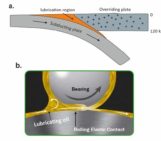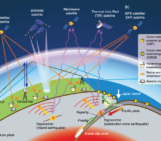
Every week, The Sassy Scientist answers a question on geodynamics, related topics, academic life, the universe or anything in between with a healthy dose of sarcasm. Do you have a question for The Sassy Scientist? Submit your question here or leave a comment below.
In a comment on a post about the key papers in geodynamics, the Curmudgeonly Commenter asked:
Could you please point out some exceptionally important papers in geodynamics and tell us something interesting about the history of the field?
Dear CC,
Over the past few weeks (it’s almost been an entire month! time flies when you’re having fun) we’ve been mainly been discussing early seismological observations and theory, rock mechanics and of course our beloved discipline: geodynamics. But — and I know this is hard to believe — there are also other disciplines looking into earthquakes. Who knew, right? This week, I’ll give them a little limelight.
Other observations: geodesy
Whereas the rock mechanics researchers were focussed on comparing their results to seismological observations, other researchers were more interested in potential surface expressions and uncovering whether any more aspects of the earthquake cycle were missing. Geodesy, can’t live without it. With the advent of GNSS data — GNSS = Global Navigation Satellite System; GPS is the American, GLONASS the Russian, Galileo the European, and (in 2020) BeiDou the Chinese system — came a wondrous richness of information of surface deformation (Ryan and Ma 1998; Bastos et al. 2010). Finally we have a fully 3D vector of surface deformation with (generally) very small error margins. This is nothing compared to the wonder of (Inferometric) Synthetic Aperture Radar — a.k.a (In)SAR — which provides high-resolution, continuous displacement fields of the surface based on the reflection of a beam sent down to the Earth’s surface from a satellite (e.g., Zebker et al. 1994; Bürgmann et al. 2000). One note should be made here; not every environment is particularly suited for every satellite that provides InSAR since the resolution and power of the satellite-sourced beams is variable. Therefore InSAR is most often used to detect the surface deformation of objects such as volcanos and areas that are arid, i.e., unvegetated, even though the newest generation of satellites can actually ‘look through’ vegetation. Since InSAR only measures the reflection of a single beam, one only obtains the deformation in that one (the so-called line-of-sight) direction: not a 3D deformation field as with GNSS. However, combining several images with different lines-of-sight introduces the possibility to resolve a complete 3D deformation field (Fialko et al. 2001; Wright et al. 2004), which can be further enhanced by the inclusion of GNSS vectors (e.g., Wang and Wright 2012). So much more data to invert for! Now we must be exactly sure that we know exactly what happens at and around the fault interface before, during, and after major earthquakes, right? …. Right? Well, we don’t. Easy conclusion, I know.
So why is it still so hard, you ask me? Well, there are some additional complexities. Come back next week if you want to find out what they are.
Yours truly,
The Sassy Scientist
PS: This post was written using only some observations. Some are still missing to foster a full picture.
References: Bastos, L., Bos, M.S. and Fernandes, R. (2010), Deformation and Tectonics: Contribution of GPS Measurements to Plate Tectonics – Overview and Recent Developments. doi:10.1007/978-3-642-11741-1_5. In: Sciences of Geodesy - I, Chapter: 5, Publisher: Springer Berlin Heidelberg, Editors: Guochang Xu Bürgmann, R., Rosen, P. and Fielding, E. (2000), Synthetic Aperture Radar interferometry to measure Earth’s surface topography and its deformation. Annual Reviews of Earth and Planetary Science, 28, 169–209. Fialko, Y., Simons, M. and Agnew, D. (2001), The complete (3-D) surface displacement field in the epicentral area of the 1999 Mw 7.1 Hector Mine earthquake, California, from space geodetic observations. Geophysical Research Letters, 28(16), 3063–3066. Ryan, J.W. and Ma, C. (1998), NASA-GSFC's geodetic VLBI program: a twenty-year retrospective. Physics and Chemistry of the Earth, 23, 9–10, 1041-1052. Wang, H. and Wright, T. (2012). Satellite geodetic imaging reveals internal deformation of western Tibet. Geophysical Research Letters, 39(7). Wright, T.J., Parsons, B.E. and Lu, Z. (2004). Toward mapping surface deformation in three dimensions using InSAR. Geophysical Research Letters, 31(1). Zebker, H.A., Rosen, P.A., Goldstein, R.M., Gabriel, A. and Werner C.L. (1994), On the derivation of coseismic displacement fields using differential radar interferometry—the Landers earthquake. Journal of Geophysical Research, 99:19617–34.



